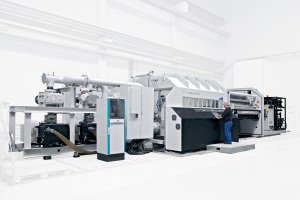Jul 1 2010
Did you ever open a freshly-bought cereal or bag of potato-chips that was not fresh at all? Did it taste sticky and rubber-like? To prevent unpleasant surprises like this, researchers from the Fraunhofer Institute for Electron Beam and Plasma Technology (Fraunhofer FEP) in Dresden developed a method to coat plastic foils with a very thin barrier layer that keeps out humidity and oxygen, the main culprits of food deterioration. In addition to extending freshness, the new coating is transparent, allowing the consumer to visually appraise the food.
 Applied Materials' TopMet Clear 2450 vacuum roll coater. (Photo: Applied Materials, Inc.)
Applied Materials' TopMet Clear 2450 vacuum roll coater. (Photo: Applied Materials, Inc.)
The key technology that enables this innovation is a vacuum-based, roll-to-roll coating process that can coat several thousand square meters of foil in a single hour. The foil, which can be a common plastic like PET, polypropylene (PP) or polylactic acid (PLA), is coated with a very thin layer of a natural oxide, which hinders the diffusion of humidity or oxygen into the package. This technology provides one of the best and most effective barriers against moisture for transparent foils in the packaging sector to date.
The advantages for the consumer are obvious: longer freshness and transparency, but the technology offers important benefits for the packaging industry as well. The coating process is very efficient and fast and therefore delivers a cost-effective solution for packaging many materials. Dr. Nicolas Schiller, head of the business unit »Coating of Flexible Products« at the Fraunhofer FEP, added, »The roll-to-roll barrier coating is suitable for a wide spectrum of polymeric materials. This makes the technology applicable and affordable for a broad range of products.« The nanometer-thin coating also helps conserve resources, since the barrier can be a hundred times thinner than traditional layers while retaining the same barrier properties. In addition, the new technique eliminates chlorine, a chemistry traditionally used in the production of polymeric barriers.
The development of the plasma assisted vacuum technology was a result of a cooperative effort between the Fraunhofer FEP research institute and two companies from Dresden. The Fraunhofer FEP developed the plasma technology and key components, while Vacuum Technology Dresden (VTD) GmbH provided the hollow cathode as a plasma source and the ISA GmbH equipped the team with the power supply system.
Applied Materials, Inc., a leading supplier of manufacturing equipment for the semiconductor, flat panel display, solar and other industries, worked closely with Fraunhofer FEP in commercializing this technology. John Busch, from Applied’s Web Coating Products division in Alzenau, Germany, remarked, »Applied Materials has successfully integrated Fraunhofer’s plasma technology into a new line of industrial vacuum roll coaters. This involved the scaling up of key components and a joint effort to improve existing processes. We are very pleased that our collaboration with Fraunhofer FEP has resulted in a system to enable their advanced coating technology to become available for large-scale packaging production.«
The effort further benefited by its collaboration with Biofilm S.A., a leading manufacturer of packaging materials, who contributed their vast experience in the manufacturing of foils to the development of the new coating technology. Mauricio Moreno, CEO of Biofilm in Columbia and Mexico, emphasized, »With this new technology we have succeeded in bringing Biofilm’s innovative film capabilities to the transparent packaging market.«
The first plant to use this new plasma-assisted vacuum web coating technology in production is Biofilm’s manufacturing facility in Mexico. In addition to demonstrating the commercial viability of the technology, it secured a follow-up order for the Dresden-developed plasma technology and production equipment from Applied Materials. Prof. Volker Kirchhoff, director of Fraunhofer FEP, appreciates this achievement, commenting, »We are proud of the success of this first plant, since we brought the technology from an idea to its incorporation at a customer’s site. The follow-up order shows that Dresden is an important focal point of plasma technology, attracting interest from the American market.« Research on the plasma technology of the roll-to-roll coating method was funded by the Saxon State Ministry for Economic Affairs, Labor and Transport (SMWA) and by the German federal ministry of education and research (BMBF).